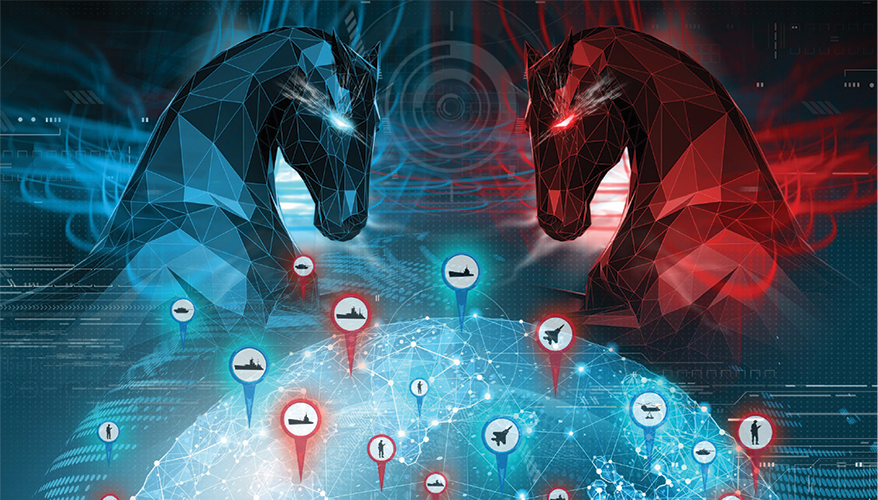ALGORITHMIC WARFARE ROBOTICS AND AUTONOMOUS SYSTEMS
Marine Wargames Blending AI with Human Thinking
By Laura Heckmann

BAE Systems illustration
Wargames, as old as civilization, have evolved from lines in the sand to bytes in the cloud. Despite evolving technologies, experts insist the games remain human-centric — but that doesn’t mean artificial intelligence can’t help.
Wargaming today is in generation 2.5, said Tim Barrick, retired colonel and director of wargaming at Marine Corps University. Drawing on theories presented by renowned wargamer Matthew Caffrey Jr., a retired Air Force colonel, wargaming today is in the “next generation,” or the follow-up to the second generation that sprouted in 19th century Prussia — widely regarded as the birth of modern wargaming — Barrick said.
In some ways, the approach really hasn’t changed since Prussia, he said — it just has computers to help do it better.
Barrick said the wargaming program at Marine Corps University approaches the task from an educational standpoint — cultivating cognitive skills, critical thinking, creative problem solving and decision making. Utilizing online platforms such as social media and podcasting has allowed a community of knowledge and collaboration to “rapidly cultivate,” while also drawing on the cloud as a virtual wargaming arena, he said at the Modern Day Marine conference in June.
So, what will push capabilities Barrick described as “at the leading edge” into the next generation?
Third generation wargaming, according to Caffrey, is about understanding the human dimension of warfare, Barrick said. This includes successfully modeling what he called system effects, or “how do you examine the interaction of systems that if you impact one, and then it has an effect on another? That’s really difficult to do.”
Artificial intelligence can help get there, he said.
What that looks like could be anything from enabling planning and decision making to rapid analysis of terrain and weather, “and synthesizing information then distilling it down into a form that helps planners rapidly gain awareness of a situation and come to a decision in a faster way than doing it manually,” Barrick said.
One key word in his description was “enabling” — AI won’t be calling the shots. It will be a partner.
One challenge of modern wargaming is all-domain warfare, requiring situational awareness across land, air, sea, space and cyber, Barrick said.
Conceptualizing all-domain warfare can create what he called “cognitive overload.”
“This is where artificial intelligence and visualization can help a staff that may be at cognitive overload because of … all the information that’s coming in across all domains,” he said. AI tools can help identify details buried within complex, chaotic scenarios, such as an alert notifying the player they’re within the threat range of three different weapon systems.
“That’s where I think we could really get this partnering between human-machine teaming with artificial intelligence to help us … gain and maintain situational awareness,” he said.
Barrick described artificial intelligence as a force multiplier, not a human replacement.
Col. George Schreffler, director of the wargaming division at the Marine Corps Warfighting Lab, said he doesn’t think artificial intelligence is going to replace human decision making.
Artificial intelligence within wargaming software is “very useful” for data “you can’t possibly replicate … because you can’t have enough players and enough space and enough time to do it all and then stitch it all together,” Schreffler said.
Computer simulations and “those that are enabled by artificial intelligence” create an opportunity to get ahead, he said. But a human “always has to give the orders to the machine.”
Barrick said AI’s role in games also depends on the purpose of the game. In those focused on analysis and gathering large amounts of data, “you’re going to abdicate some of that decision making … to artificial intelligence.”
In games where the purpose is high-ranking decision making, the player might issue a three star level order, but artificial intelligence can take over the tactical units and employ them, Barrick said.
While the Marine Corps doesn’t intend to hand over human decision making to AI, it is planning to use a wargaming solution that figured out how to replicate it.
The Pioneer wargaming solution is being developed by a network of small businesses under the umbrella of BAE Systems to be used in the Marine Corps’ new wargaming and analysis center. The center is currently under construction and eyeing 2025 for initial operating capability, but the program is ready “to be used tomorrow,” Marcus Mainz, CEO of Covan Group — one of several small businesses under the BAE Systems umbrella — said in an interview at Modern Day Marine.
The web-based, multi-domain program incorporates a gaming theory conceptually developed in 1972 by Russian mathematician Boris Stilman. Through a series of experiments ranging from chess games in Russia to a DARPA program in the late 1990s, Stilman cracked the code on replicating human decision making in artificial intelligence, Mainz said.
The point isn’t to hand human decisions over to AI, but to enable human decision making by using AI to approach problems from a more human perspective. Stilman eliminated calculations and search field shortcuts normally used in game solving that would “never work in real warfare,” Mainz said.
The human is still giving the initial strategy, he said. “We’re not giving you some black box AI that’s going to [say], ‘Don’t tell me how to win, I’ll tell you.’ That’s not going to work in the military, and nor are we willing to trust our sons’ and daughters’ lives to something like that,” Mainz said. “And it doesn’t help us become better thinkers overall. We know we want humans giving commands.”
Ultimately, a sophisticated gaming system infused with artificial intelligence is still rooted in the same principles found in ancient wargames, summarized by Barrick in the Marine Corps University mission: “Cultivating those cognitive skills, critical thinking, solving problems creatively [and] decision making.” ND
Topics: Marine Corps News
